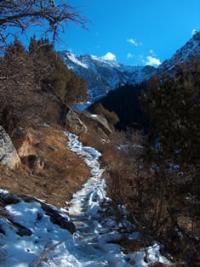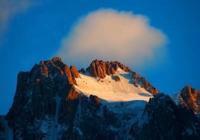You are here
Ala-Archa park.


Routes in Ala-Archa park.
"Ala-Archa, Ala-Archa,
Water runs from the heavenly mountains.
Your beginning is Ala-Archa,
Where everlasting snow lies.
Ala-Archa, Ala-Archa,
ou know the secrets of glaciers
And the sound of the waters, - Ala-Archa
You give music without words"
A.Yu. Prikhodko.
Walk from Bishkek to Ala-Archa park.
Ala-Archa Park is located in the gorge of the same name, 26 kilometers south-west of Bishkek on the northern slope of the Kyrgyz Ala-Too ridge in the Alamudun district of the Chui oblast. Ala-Archa Natural Park was founded in 1976.
Ala-Archa in translation from Kyrgyz means "Variegated archa". This name was given to the gorge because of the abundant thickets, both tree-like and creeping juniper, covering its slopes. The location of the park was chosen due to its ecological diversity, as well as its proximity to the city of Bishkek.
The flora of the park is unusually rich: 600 species of plants and 70 varieties of trees and shrubs, more than 50 of which have unique medicinal properties. Most of the territory is represented by juniper bushes and Tien Shan spruce.
Here you can see birch, poplar, willow, pine, larch. Shrubs make up about 180 hectares of the total area of the reserve. The most famous plants are red and white tulip, primrose and forget-me-not. Another attraction of the reserve is the diverse world of fauna.
Porcupines and foxes, wolves and roe deer live here. You can see the hare and ermine, marten, wild boar and marmots. The most famous animals are the sailing butterfly, the golden eagle, the snow vulture, the Turkestan lynx and the snow leopard.
Three main rivers flow in the park, of which the largest is the Ala-Archa, it has two large tributaries, the Ak-Sai and Adygin. At present, the glaciers of the Ala-Archi basin, like all glaciers of the Kyrgyz ridge, are rapidly retreating.
So, the Golubin glacier, for example, from 1937 to 1948 saw a 1 kilometer indent, revealing a narrow deep canyon. The main role in the creation of the modern relief of the Kir¬giz ridge belongs to the alpine mountain-building cycle.
Its powerful tectonic movements were expressed in a vaulted uplift and in a gentle bending of large parts of the Mesozoic platform, as a result of which the isolation of two main elements - ridges and depressions - occurred.
Alpine mountain building reaches its highest intensity in the second half of the Neogene and especially at the beginning of the Quaternary period. During this time, the rising mountain ranges underwent further tectonic transformation.
Various faults and faults took place. In sagging depressions, a thick stratum of clastic rocks was deposited, subject to crushing. The arched uplift contributed to the rise of the mountains. As a result, a cooling of the climate began, which created a large glaciation of the mountains.
The ancient glaciation, especially its second phase, which is likely to come from the Upper Pleistocene, left bright traces in the modern appearance of the Northern Tien-Shan. In the Ala-Archi basin, ancient Paleozoic bionite and amphibole granites are developed, breaking through the formations of Lower Paleozoic sandstones, phyllites and conglomerates. In the lower reaches of the Ala-Archi, at the exit from the mountains, a formation of Hercynian effusive rocks is developed, represented mainly by diabases and quartz porphyries.
This suite is overlapped by the only one within the region During the Soviet era, the park was a popular climbing area. Alpine camp "Ala-Aarcha" is located in the gorge of the same name, 45 kilometers south of the capital of Kyrgyzstan, Bishkek, at an altitude of 2100 meters above sea level, in a wide and fairly open part of the valley in this place.
The camp was organized in 1953. The Central Council of the Iskra Voluntary Sports Society.
Geographic coordinates of the park "Ala-Archa": N42 ° 35'11.87 "E74 ° 28'54.30"
Authority:
A. Kuznetsov "Alaarcha". “Defeated peaks. 1973 - 1974". “Mysl”. Publishing House, 1976.
Photos by
Alexander Petrov.







